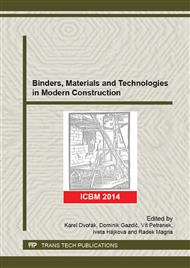p.156
p.162
p.166
p.170
p.174
p.178
p.185
p.189
p.193
Possibilities of Sugar Content Reduction in Filler of Cement-Bonded Particleboards
Abstract:
This paper presents the results and findings of carbohydrate-content reduction of wooden substances (particles) that are used as filler in cement-bonded particleboards. Several alternatives that appeared as potentially suitable were analysed. The aim of research was to control the carbohydrate level in the wood matter with regards to the reduction of their negative impact on speed and course of the hydration reactions in cement-bonded particleboards. In experimental testing an/the attention was particularly devoted to washout of wood chips by running water and chemical hydrolysis with/by oxidizing agents.
Info:
Periodical:
Pages:
174-177
Citation:
Online since:
April 2015
Authors:
Keywords:
Price:
Сopyright:
© 2015 Trans Tech Publications Ltd. All Rights Reserved
Share:
Citation:


